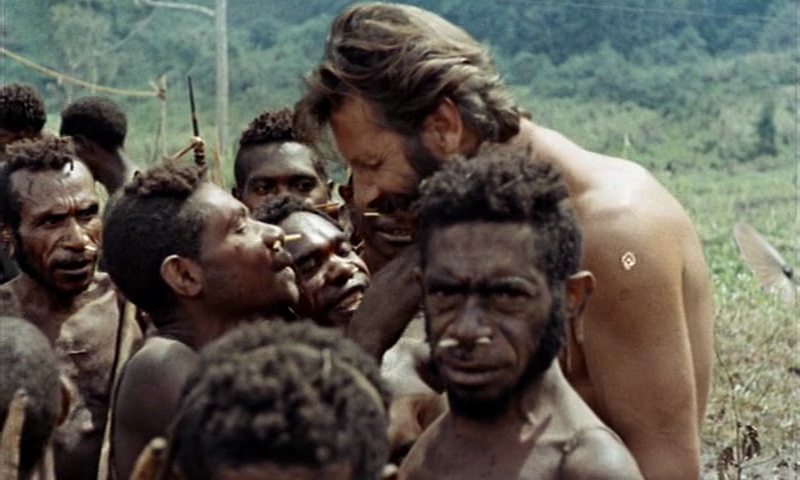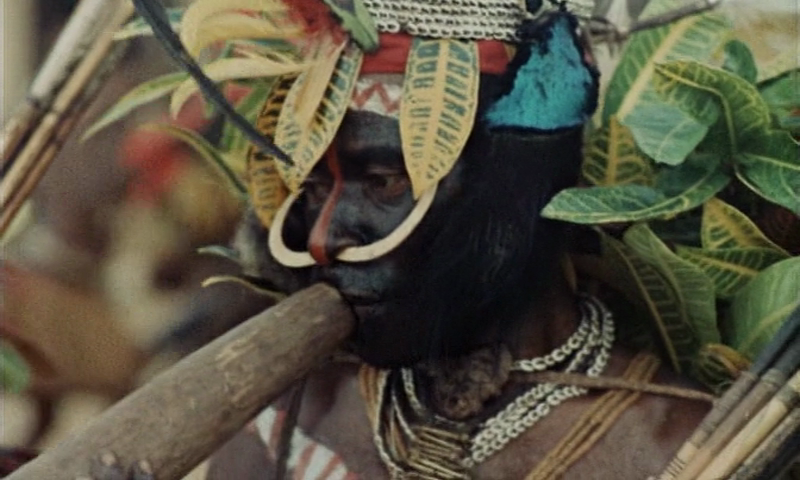Sky Above, the Mud Below, The (1961)
“We are here just as observers — and, if they will let us be, as friends.”
|
Synopsis: |
|
Genres, Themes, Actors, and Directors:
Review: At the same time, it’s hard not to feel at least mildly distressed by the exoticizing tone of both the solemn voiceover (“They say in the jungle, only fools and children ask questions.”) and many of the scenes — beginning with a staged introduction as the adventurers and a pretty stewardess smile while pointing to various locations on a globe (good thing they had that with them on the plane). As nudity, dramatic body piercings, and unsettling tribal customs (i.e., bare-breasted women suckle not just human babies but animals and adult guests) are put on display, we wish it were less obvious how superior the explorers feel to their “stone age” counterparts. Yet the filmmakers are nothing if not direct in their explanation of how and why the journey (funded by Dutch royalty) took place, making it easier for modern audiences to place the film within historical context and forgive some patronizing elements. Audiences at the time were surely enthralled by the opportunity to glimpse the lives of fellow humans so completely untouched by global influence — and modern film fanatics will likely be, too. Note: Viewers interested in this subject matter and area of the world might want to check out the more recent documentary The Search for Michael Rockefeller (2011), which weaves similar footage from the same era into an investigation of the famous heir’s mysterious disappearance. Also recommended is the National Geographic documentary series based on Gerald Diamond’s Guns, Germs and Steel (2005). Redeeming Qualities and Moments: Must See? Categories
Links: |




One thought on “Sky Above, the Mud Below, The (1961)”
A once-must – because, well…it’s a sobering, humbling experience. My guess is that only those who maintain a steady diet of documentaries or those who keep themselves open to the occasional documentary will actually see it.
I can’t comment on the statement that there is a “patronizing” air within the film. (I’m no Margaret Mead.) But it doesn’t feel that way to me – nor did I sense that the filmmakers felt at all “superior” to the subjects of their study. I felt a sense of honest respect throughout. More than that, really – a sense of awe and wonder.
Given the conditions, the filming is rather immaculate and even artistic.
Personally, I couldn’t stop wondering about the customs and traditions of the various tribes. How did they acquire them?, and get all tribal members to agree to follow them – especially (often) in such elaborate detail? But I was mostly relieved that the filmmakers didn’t seem to encounter actual life-and-death situations as far as the natives were concerned. Their subjects seemed, overall, to not mind being captured on film – and, if there were things not to be seen…well, word simply got to the filmmakers that certain things were off-limits.
Certainly a one-of-a-kind film experience – which deserved its Oscar.